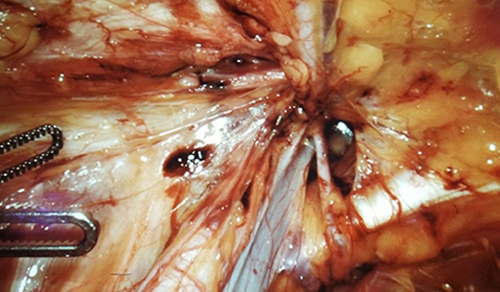A Singular Focus on the Spine

Dr. Lawrence G. Lenke
Three years ago, NewYork-Presbyterian launched a spine hospital with its guiding principle of providing, under a single roof, a world-class center to treat the full range of conditions that can affect the spine. It was to be a spine hospital that would summon an integration of medical and surgical experts in multiple disciplines and establish programs for advanced research and education for new and seasoned physicians.
Three renowned spine surgeons — Lawrence G. Lenke, MD, Surgeon-in-Chief of the Daniel and Jane Och Spine Hospital; K. Daniel Riew, MD, Director, Cervical Spine Surgery; and Ronald A. Lehman, Jr., MD, Director of Degenerative and Minimally Invasive Spine Surgery — came on board to steer this singularly focused endeavor for spinal care.
Today, just three years later, the Daniel and Jane Och Spine Hospital has emerged as a destination for an increasing number of patients with complex and challenging spinal problems. Here, they find an integrated approach that unites the expertise of orthopedic spinal surgeons, neurosurgeons, physiatrists, pain management specialists, physical therapists, and specialized nursing staff.
The Spine Hospital’s surgical team is trained in the most advanced, least-invasive surgical techniques, including microsurgical and endovascular options. For the most complex spinal deformity surgeries — many of which can be performed at only a few hospitals in the world — they employ CT imaging data to create 3D models in order to precisely plan the placement of screws and other aligning techniques before and during surgery.

The Daniel and Jane Och Spine Hospital
- 2 operating rooms custom built for spine surgeries
- ICU beds attended by spine-specific intensivists
- Low radiation EOS X-ray imaging and 3D computed tomography
- Robotics system
- Real-time OR video feed to surgery observation rooms
Robotic technology is now being used as a tool to enhance positioning accuracy, minimize invasiveness, and reduce radiation exposure to the patient and surgical team during spine surgeries. The bone-mounted, miniature robotic system guides the accurate placement of implants, offering surgical tool guidance while leaving the actual procedure in the surgeon’s hands.
“The entire Spine Hospital is set up to manage all surgical patients, from the most straightforward to the most challenging patients, from their first appointment through rehabilitation and recovery,” says Dr. Lenke. “The surgical suites are designed explicitly for spinal procedures so we can perform complex procedures with attention placed on optimal patient positioning, while also providing appropriate access for anesthesia, the spinal cord/nerve root monitoring team, as well as intraoperative CT scans, X-rays, and fluoroscopy, all with an eye towards reducing complications. Patient care is coordinated with NewYork-Presbyterian’s hospitalists, intensivists, cardiologists, endocrinologists, pulmonologists, and other specialists to optimize surgical outcomes and expedite recovery following surgery. You need a diverse and committed team to take care of these complex patients — ensuring the coordination of all aspects of preoperative, intraoperative, and postoperative treatment — in order to achieve the best outcomes.”
A Destination for Challenging Cases
Dr. Lenke, a celebrated spine surgeon, researcher, and educator, treats patients with the most extreme and atypical deformities. Since its inception, the Spine Hospital has drawn an increased array of the most challenging cases. In fact, Dr. Lenke points to one patient who presented with one of the severest deformities he has ever seen. The 28-year-old woman had come to America from Russia to pursue an advanced degree in spite of several daunting medical challenges, including Marfan syndrome and having had two open-heart procedures.
“She was studying for her master’s degree in Cleveland,” says Dr. Lenke. “Cleveland Clinic, which was handling her heart issues, sent her to me to fix her spine, which had a greater than 160° scoliosis. Based on her preop condition, most hospitals would have said that she was inoperable. We were able to offer her a surgical solution that required having a complete spine reconstruction from her cervical C2 vertebrae to her pelvis. Her entire spine had to be reconstructed because it was that collapsed.”
The patient’s first phase of treatment involved halo traction prior to undergoing two 10-hour surgeries to correct her deformity. “Not many hospitals specialize in this type of traction,” notes Dr. Lenke. “These patients need highly specialized physical, nutritional, and respiratory therapy.”
Dr. Lenke then performed a vertebral column resection (VCR), an advanced procedure for which he is well known. “We used a new dual-headed screw that has one shank, which enables us to put in a temporary rod in one of the heads to hold the spine in position as we put a permanent rod in the other head,” explains Dr. Lenke. “In this way, we don’t have to shift out our equipment as we try to stabilize the spine during VCR procedures, which entails making the spine very unstable. It’s a huge benefit. I had the opportunity to use these dual-headed screws for several months prior to her surgery, and it was extremely helpful to this patient.”
Given her heart condition, the patient was very fragile from a medical perspective. “It took a variety of expertise from our medical team to help manage her postoperatively during her six-week hospitalization,” adds Dr. Lenke. “She has done spectacularly well coming through surgery and is now back home in Cleveland getting ready to restart her master’s program. It’s a reflection of the entire team effort and the expertise that we have not only in spine surgery, but in critical care, pulmonology, and all other areas of medicine required to manage this kind of complex patient.”
Spine Study Team Wins Prestigious Whitecloud Award at IMAST
Lawrence G. Lenke, MD, Chief of the Spine Division, along with J. Alex Sielatycki, MD, Comprehensive Spine Fellow; Eduardo Beauchamp, MD, Advanced Pediatric Spinal Deformity Fellow; and Meghan Cerpa, MPH, Research Coordinator, have won the prestigious Thomas Whitecloud Award at the 2018 International Meeting on Advanced Spine Techniques (IMAST). The award was presented for their paper, “The Relative Curve Correction is More Important than UIV Selection for Shoulder Balance in Lenke Type 1 and 2 AIS,” where Dr. Sielatycki was the first author and presenter. The Whitecloud Award is given to the best basic and clinical science papers at IMAST, one of the most important spine research meetings of the year. The meeting is sponsored by the Scoliosis Research Society and was held in Los Angeles in July.
Related Publications

An Integrated Orthopedic and Neurosurgery Spine Fellowship

Sharing Expertise with International Colleagues

Intervertebral Discs: From Degeneration to Regeneration








